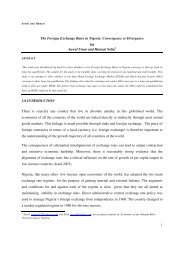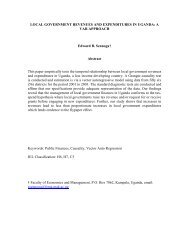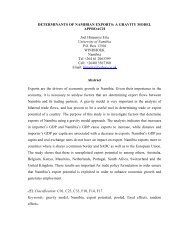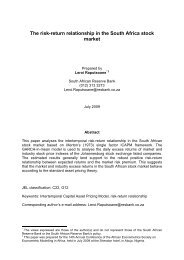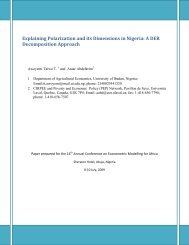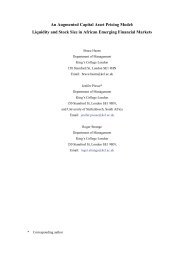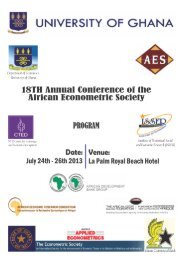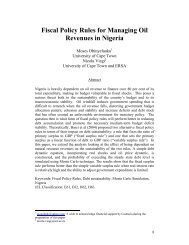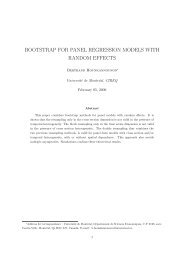Dynamic Effects of Monetary Policy Shocks in Malawi* - African ...
Dynamic Effects of Monetary Policy Shocks in Malawi* - African ...
Dynamic Effects of Monetary Policy Shocks in Malawi* - African ...
You also want an ePaper? Increase the reach of your titles
YUMPU automatically turns print PDFs into web optimized ePapers that Google loves.
1.0. INTRODUCTIONWhile it is generally agreed that monetary policy can significantly affect both real economicactivity and prices <strong>in</strong> the short run and only prices <strong>in</strong> the long run, considerable debate rema<strong>in</strong>sabout how monetary policy shocks are transmitted. Views differ <strong>in</strong> the emphasis placed onmoney, credit, <strong>in</strong>terest rates, exchange rates, asset prices and the role <strong>of</strong> commercial banks andother f<strong>in</strong>ancial <strong>in</strong>stitutions (Taylor, 1995). The differences are prevalent even <strong>in</strong> <strong>in</strong>dividual<strong>in</strong>dustrialized countries where the topic has been a subject <strong>of</strong> research for many years. Indevelop<strong>in</strong>g countries, the process is even more uncerta<strong>in</strong> (Kam<strong>in</strong>, Turner, & Van't dack, 1998).In spite <strong>of</strong> the prom<strong>in</strong>ence given to monetary policy, the transmission process <strong>in</strong> a typicaldevelop<strong>in</strong>g country is not well understood (Montiel, 1991). One <strong>of</strong> the typical develop<strong>in</strong>gcountries, Malawi, is no exception.<strong>Monetary</strong> policy plays a very important role <strong>in</strong> the management <strong>of</strong> the Malawi economy. Asoutl<strong>in</strong>ed <strong>in</strong> the Reserve Bank <strong>of</strong> Malawi (RBM) Act <strong>of</strong> 1989, one <strong>of</strong> the pr<strong>in</strong>cipal objectives <strong>of</strong>the central bank is to <strong>in</strong>fluence money supply, credit availability, <strong>in</strong>terest rates and exchangerates <strong>in</strong> order to ultimately promote economic growth, employment and price stability (MalawiGovernment, 1989). Achiev<strong>in</strong>g this objective clearly requires an understand<strong>in</strong>g <strong>of</strong> the processthrough which monetary policy affects economic activity. There is, however, no study that weare aware <strong>of</strong> that has quantitatively measured the transmission process <strong>of</strong> monetary policy <strong>in</strong>Malawi. This study, therefore, contributes to the literature by fill<strong>in</strong>g this gap. The study isolatesmonetary policy autonomous disturbances from other shocks, quantifies their dynamic behaviourand measures the consequent macroeconomic implications us<strong>in</strong>g a structural vectorautoregressive model (SVAR) with short run restrictions. With<strong>in</strong> the same framework, the studyalso assesses how the country‟s monetary policy transmission process was altered by RBM‟smigration from direct to <strong>in</strong>direct tools <strong>of</strong> monetary control <strong>in</strong> the late 1980s and 1990s.S<strong>in</strong>ce Sims‟ (1980) pioneer<strong>in</strong>g work, vector autoregression models (VARs) are consideredbenchmarks <strong>in</strong> econometric modell<strong>in</strong>g <strong>of</strong> monetary policy transmission (Borys & Horvath,2007). While natural experiments would be ideal, the real world does not provide for this optionand SVARs are the only other place where experiments can be performed (Christiano,Eichenbaum, & Evans, 1998). SVAR experiments aimed at measur<strong>in</strong>g the effect <strong>of</strong> monetarypolicy on economic activity have traditionally <strong>in</strong>volved sett<strong>in</strong>g apart monetary policy shocks andtrack<strong>in</strong>g the response <strong>of</strong> macroeconomic variables to the monetary policy impulses.Most studies that have applied SVARs to study the dynamic behaviour <strong>of</strong> monetary policyshocks have used developed market economies as case studies (Karame & Olmedo, 2002;Bernanke & Mihov, 1998; Sims & Zha, 1998; Bernanke & Mihov, 1996; Piffanelli, 2001). Inrecent years, there has been grow<strong>in</strong>g attention on emerg<strong>in</strong>g market economies <strong>of</strong> Lat<strong>in</strong> America,Asia and Easten Europe (Borys & Horvath, 2007; Vonnak, 2005; Disyatat & Vongs<strong>in</strong>sirikul,2003; Dabla-Norris & Floerkemeier, 2006) and on Australia (Berkelmans, 2005; Brischetto &Voss, 1999). In contrast, quasi-emerg<strong>in</strong>g market economies (QEMEs), particularly <strong>in</strong> subsaharanAfrica, have attracted very little attention.2 | P a g e



